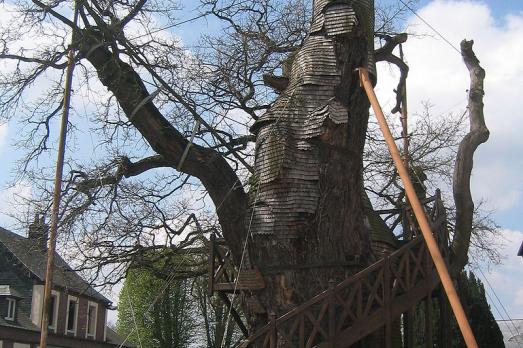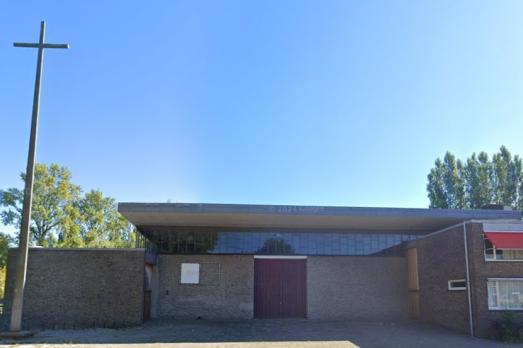O.L. Vrouw Hulp der Christenen
Nieuwenhagen, NL
Neo-Romanesque church with tower. This church is listed as a National Monument of the Netherlands.
Here you can search for a building to visit. You can use the map find destinations, or you can use the filters to search for a building based upon what different criteria.
Nieuwenhagen, NL
Neo-Romanesque church with tower. This church is listed as a National Monument of the Netherlands.
Leiden, NL
Large, iconic neoclassical church with tower, in the middle of the shopping area in the centre of Leiden. The exterior of the Hartebrugkerk - officially: Roman Catholic Church of Our Lady of the Immaculate Conception - was restored in the late 1990s. The interior was also restored in the early 2000s, and so the church on Haarlemmerstraat was put back into use on 30 November 2003. The church dates from 1835-1836 and was designed by Th. Molkenboer. In mid-2003 it was announced that the parishes of St. Peter, St. Joseph and Our Lady of the Immaculate Conception (Hartebrugkerk) would be working together. These three church buildings will continue to exist. The Roman Catholic Lodewijk parish will not participate, because it has a more conservative signature. The church was built in 1835 to a design by Leiden architect Theo Molkenboer. The church is a so-called "Waterstaatskerk". This means that churches were built with financial support from the national government. This happened between 1824 and 1875. The design and construction of such churches was subject to the approval and control of engineers from the Ministry of Public Works. The Hartebrugkerk was built in Neoclassical style and has a striking facade. Typical of this style are the Greek temple fronts. The Hartebrugkerk also has such a temple front, built with Ionic columns. Above that is an architrave with a large triangular pediment. On the architrave is a Latin text: "Domus Dei Est Et Porta Coeli" which means "This is the house of the Lord and the gate of heaven". Because of this inscription in large letters on the facade, a nickname of the church is "Coelikerk". Barrel vault with cassettes, resting on a cornice supported by Corinthian columns. Pulpit from 1880 from the studio of Te Poel and Stoltefus from The Hague. The side altars are probably from the same period. The church has an organ that was made in 1877 by M. Maarschalkerweerd (Utrecht). The Latin text on the organ reads: "Laudate Dominum in Coro et Organo" , which means: "Praise the Lord with choir singing and organ playing".
Oude-Tonge, NL
Built in 1897-1898 to a design by Joseph Cuypers (1861 - 1949) in neo-Gothic style, as a successor to the old parish church from 1759 on the Achterweg. The executor was the Hilversum contractor Jac. Groenendaal. The pseudo-basilica, built under pastor BJ Klekamp, features sculptures from the old parish church and stained glass and altars from the construction period, made in the studio of Jos Cuypers. The painted Stations of the Cross from 1927 were made by Kees Rovers from Voorburg. The murals, as well as some stained glass windows, were made by Henk Asperslagh. Some of the original murals by CA Dunselman were replaced in 1941-1942 by paintings by Asperlagh and after the flood disaster of 1953 the remaining paintings by Dunselman were painted over with white paint. In 1934 the original communion benches were replaced by the current ones and a pulpit in a similar style was installed. The original organ was replaced in 1962 by an organ financed from the Disaster Fund by Romanus Seifert & Sohn (Kevelaer) that is not protected.
Leiden, NL
Extremely important Roman Catholic church with a high tower (53 m) and roof turret. Nickname "Herensingelkerk". New parish church in the northern city expansion of Leiden. Extremely important early work by Jan van der Laan. Also built as the first Roman Catholic parish church outside the historic canals of Leiden. In mid-2003 it was announced that the parishes of St. Peter, St. Joseph and Our Lady of the Immaculate Conception (Hartebrugkerk) would work together. The three church buildings (all 3 national monuments) will continue to exist. The Roman Catholic Lodewijk parish will not participate, because it has a more conservative signature. The Herensingelkerk is also used for Polish celebrations.
Lathum, NL
Reformed Church (OL Vrouwe). Single-nave, unvaulted Gothic church (15th century) with older three-sided closed choir and a simple west tower (15th century) with constricted spire. A net vault over the lower space of the tower. Inventory: Copper lectern and baptismal font holder (mid-18th century), baptismal font 1702. Rare single-manual cabinet organ by P. Kehrman from 1737. Bell frame with clock by H. Meurs, 1608, diam. 80 cm. Mechanical wrought-iron tower clock, later fitted with electric winding.
Driel, NL
Reformed CHURCH. Single-nave late Gothic village church, consisting of a three-sided closed choir with cross-ribbed vaults, 15th century, and a lower nave. Burned down in 1915, as well as the tower, subsequently restored and restored for the second time from 1963 to 1966. In the church a monumental Louis XIV pulpit from 1714, originating from the Augustinian monastery in Hasselt (Belgium).

Allouville-Bellefosse, FR
In the hollow trunk of the oak tree, there are two chapels (Notre-Dame-de-la-Paix and Chambre de l’Ermite) which were built in 1696. While the locals believe that the tree is 1200 years old, scientists claim that the tree is probably 800 years old. It is said that William the Conqueror, the first Norman king of England, has knelt at the base of this oak in 1035. It was only around 1600 that the tree was struck by lightning, thus forming a hollow. The oak survived and was seen as a sign from God, upon which two men decided to build a sanctuary in it. A spiral staircase around the trunk provides access to the chapels. Since 1932, the tree has been classified as a ‘monument historique’ (historic monument) by the French Ministry of Culture.
Deventer, NL
The church building was designed by the Amsterdam architectural firm Abma and Hazewinkel in 1970. The Dutch Reformed Church Oase used the building until 1984, after which the Pentecostal Church of Filadelfia took it into use.
Doornspijk, NL
Hall church without tower. Expansion, merged in 2004 with Christian Community Elburg to Gospel Community Oase.

Arnhem, NL
Roman Catholic parish church of St. Nicholas, from the early 1960s, built for the Presikhaaf expansion district. Virtually oriented large, rectangular hall church with tower in modernist/functionalist style. Out of use as Roman Catholic church in 2005. Sold to the Municipality of Arnhem.

new
The Chassidic Route is a cultural and historical trail tracing the rich legacy of Jewish communities in southeastern Poland and western Ukraine. This region was central to the rise of Chassidism in the 18th century. Here, we highlight 10 remarkable synagogues you’ll discover along this route.

he cradle of the Industrial Revolution in Germany, Chemnitz, is well-known for its industrial heritage landscape, but the city is also home to remarkable examples of religious architecture from different historical periods. Join us as we explore the key landmarks of this European Capital of Culture 2025.

The twin towns of Nova Gorica (Slovenia) and Gorizia (Italy), lying on the border between the two countries, have a rich religious heritage, steeped in centuries of tradition. If you are looking for ideas for your visit, take note of these 10 religious sites that you should not miss.